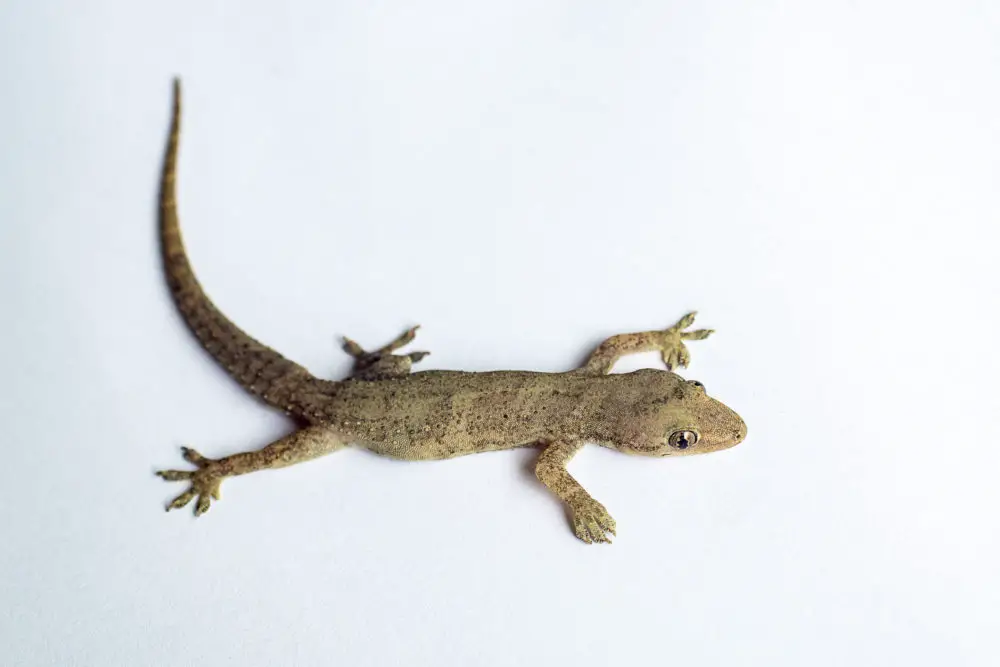Lizards are important members of the ecosystem, feeding on mosquitoes and other insects. While most lizards will be content to remain in the garden, one or two may occasionally wander inside. You can use exclusion to keep them out, and trapping to take care of any who still make it inside.
Lizards Common Around the House
There are over 4,000 species of lizard worldwide, and of the species present in the U.S., only the Gila monster is venomous.
Western Fence Lizard
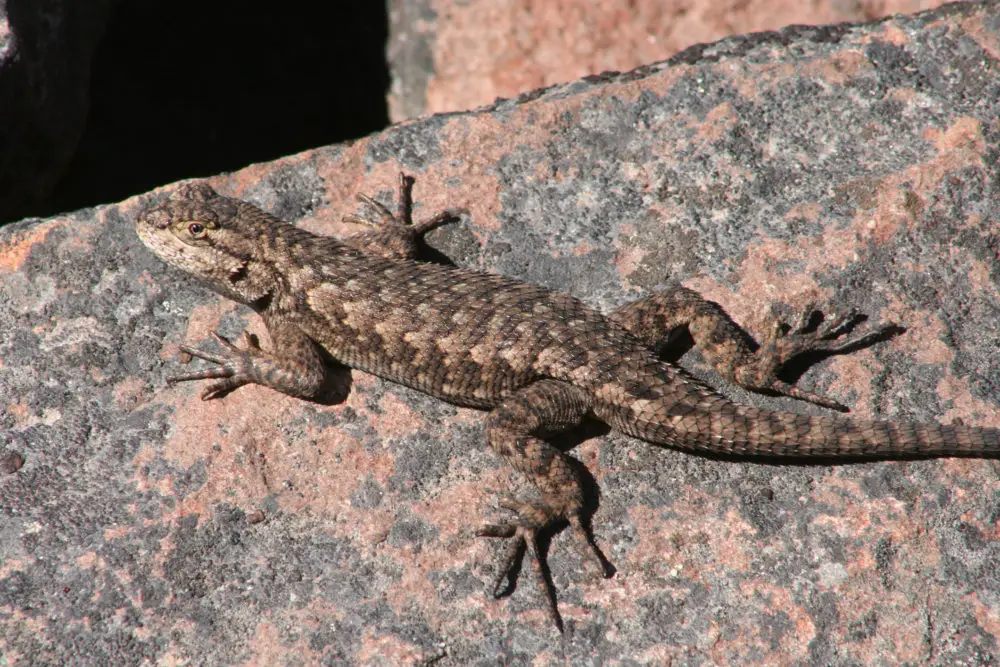
Western fence lizards are found in California, Oregon, Nevada, the Columbia River Gorge (the area between Washington and Oregon), Idaho, and Utah.
They grow to be about 8 inches long and have gray, tan, or brown spiny scales along their backs and legs with darker splotches of color. Their bellies can be white or yellow, and males can have bright blue patches on their belly and throat.
These lizards feed on beetles, flies, ants, caterpillars and spiders and can be found in grassland areas, coniferous forests, farmland, in sagebrush, and in woodlands. They tend to avoid extremes, like harsh deserts and dense, moist forests.
Brown and Green Anole
The brown anole is considered an invasive species and was introduced to South Florida from the Caribbean. Since then, this small, grayish to brown lizard has moved steadily north and can now be found in Louisiana, Coastal Georgia, and even Texas.
When they move into an area, brown anoles compete with other lizard populations for resources and have even been linked to declining green anole populations. Brown anoles are between 5 and 9 inches in size and have triangles or lines running down the dorsal side.
Females are often lighter in color than males and have a diamond-backed or scalloped pattern down their backs. Males have a brightly colored dewlap (throat fan).
Green anoles, as their name suggests, are green in color, but can also change color to brown in response to changes in temperature and humidity. They have slender bodies, long tails, and narrow heads, with a thin turquoise border around their eyes. Males also have a pink or red dewlap that they use for attracting mates and intimidating other males.
Green anoles are found in many of the same places as brown anoles, ranging from Southern Virginia to the Florida Keys and west as far as Central Texas and Oklahoma. They prefer swamps, forests, wooded beaches and other areas with high humidity and trees.
Anoles, both brown and green, eat spiders, flies, crickets, beetles, slugs, termites, butterflies, moths, and ants.
Common House Geckos
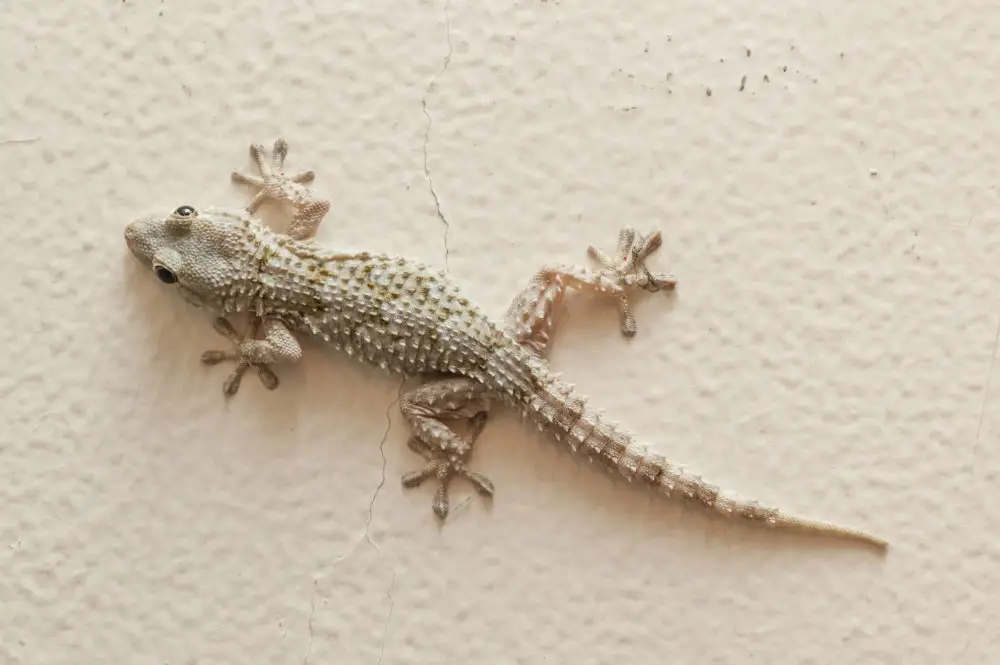
These lizards are more commonly found in Southeast Asia and the Pacific region, however, they can also be found in Florida and Hawaii. In Hawaii they are the most common gecko found on the major islands.
They are nocturnal, grayish-white with tiny dark spots on their backs, and can grow to be about 5 1/2 inches in length. They eat moths and other insects and can be found on the walls of buildings more often than not.
Green Iguanas
This lizard is considered invasive. It is native to South and Central America, Mexico, and parts of the Caribbean, but was introduced to the U.S. by the pet trade. They are now found in Florida, South Texas, Hawaii, and Puerto Rico.
Green iguanas are one of the larger lizards on this list — growing up to 6 1/2 feet long, including its tail, and weighing 10 to 15 pounds. They are an earthy green in color with dark bands on the body and tail. They also have spines running along their back.
They have powerful claws, a long tail, and a large dewlap that hangs from the throat. Males may change color, from green to a bright orange, during mating season to attract mates.
Green iguanas are arboreal, so you’ll most likely see them in areas with trees and tropical regions near water. They are mainly herbivores, feeding on vegetation and flowering plants — they will destroy your orchids and hibiscus as well as garden vegetables.
Are Lizards Beneficial?
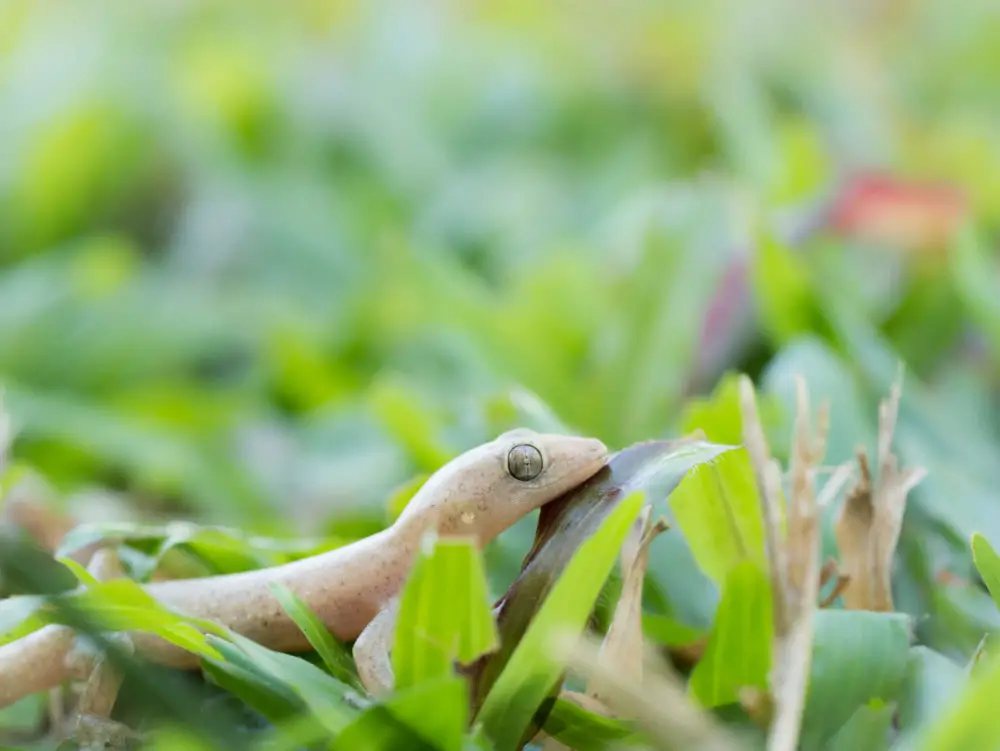
Lizards are an important part of our ecosystem and having them in your garden and near your house can keep pest populations down. We just don’t want them inside the house.
Not only do lizards eat garden pest like slugs, ants and termites, they also eat mosquitoes and ticks. Mosquitoes and ticks can transmit diseases like Lyme disease, West Nile, malaria, and dengue fever. Lizards keep pest populations down, protecting your garden plants from plant-destroying insects and protecting your family from pests that transmit these disease.
Are Lizards Dangerous?
Lizards can carry diseases and like most wild animals, will bite if they feel threatened. Here are a few things to watch out for.
Diseases
Lizards are known carriers of salmonella, which can be dangerous for small children and those with compromised immune systems. Lizard droppings can contaminate surfaces with salmonella, so make sure to clean any surfaces carefully and wash your hands afterwards.
Bites
Lizard bites usually happen when people try to handle lizards. Iguana bites often happen during breeding season when males are unusually aggressive and people accidentally frighten them. And iguana bites can be nasty.
Not only does the lizard not immediately let go following the bite, but those mouths are full of sharp teeth, making bites painful and bloody. Lizard bites need to be properly cleaned and bandaged to prevent secondary infection.
Signs you may have Lizards in your House
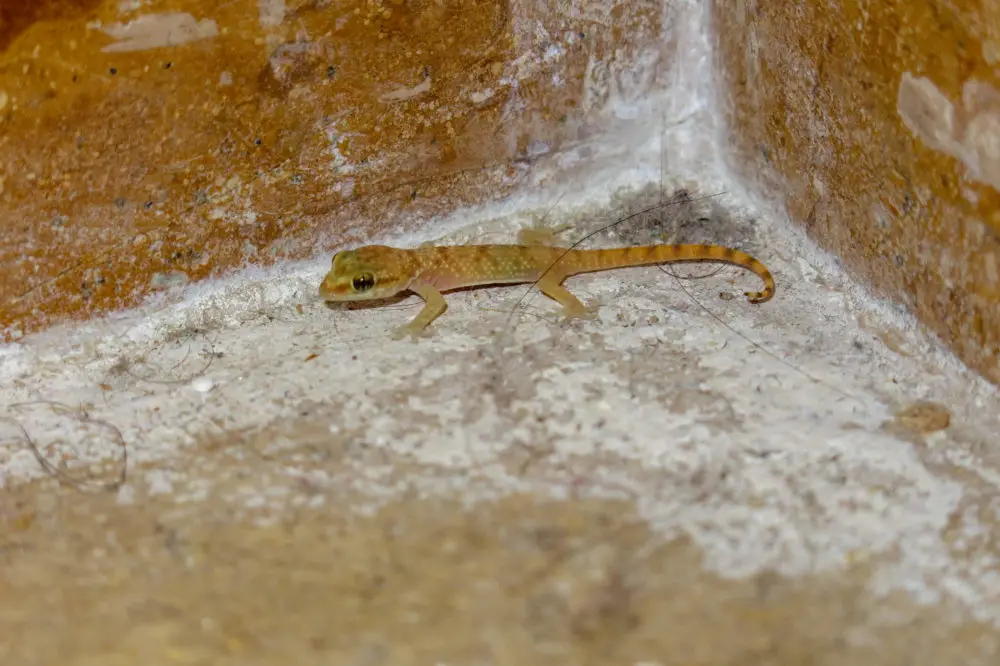
Not all lizards are as easily noticed as geckos and iguanas. Here are a few ways to spot them.
Movement
If you thought you saw something move quickly across your walls or your ceiling, it may have been a lizard. Geckos especially love hanging out on walls and they won’t always try to conceal themselves while they’re doing it, either.
Many lizards are excellent climbers, and can come inside through open windows or doors, so keep an eye out if you like to leave your house open during the warmer months.
Squeaking Noises
Most people associate squeaking noises with rodents like mice and rats. However, lizards can also make squeaking noises. Most of the lizards that wander into people’s homes are nocturnal, like the common house gecko. So hearing squeaking at night can also be associated with these small creatures.
Droppings
While the size of lizard droppings depends on the animal’s size, they’re usually easy to identify. Lizard droppings tend to have a white tip, which is from uric acid that has crystallized during the digestive process. Spotting droppings in your house could mean you have a reptilian visitor.
How to Keep Lizards Out
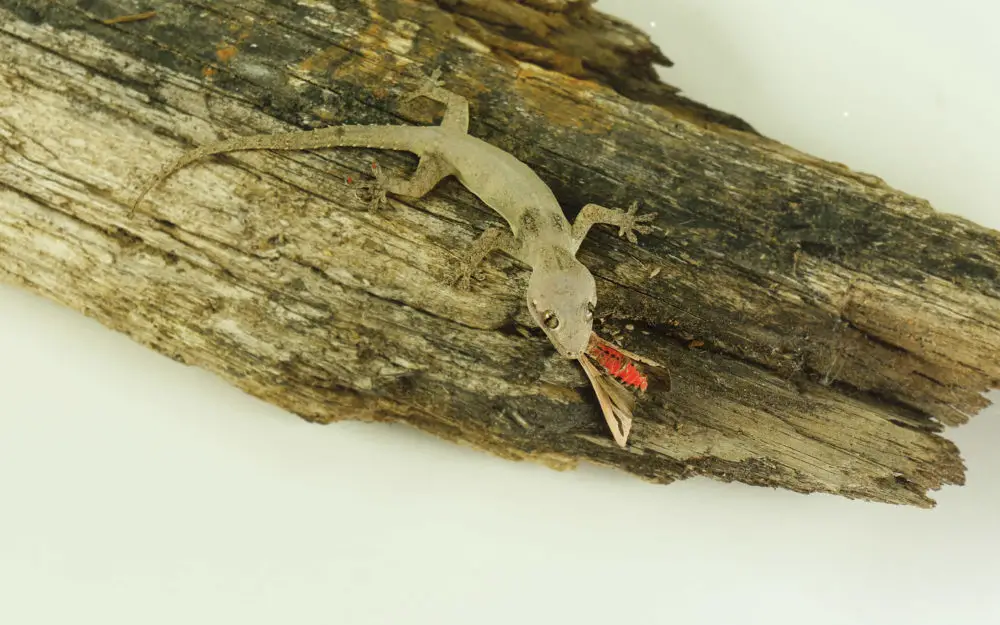
Keep Insect Populations in Check
Most lizards eat insects and will stay close to areas where they can find them. To keep lizards out, you should focus first on keeping insects out. You can use insect traps and repellents inside your house, like fly traps.
Citronella candles and other scents can help repel insects also. Light candles near windows or use diffusers throughout your house.
If you have a lot of flying insects, a bug zapper may help, but be aware that they aren’t always effective against mosquitoes who aren’t as attracted to the U.V. light as they are to you. Bug zappers also kill indiscriminately, meaning beneficial bugs will fall victim as well as pests.
To keep mosquitoes away, eliminate any standing water — which they use for spawning. And certain bug sprays can be used to keep mosquitoes away from the house.
And don’t forget to keep windows and doors properly screened if you like to keep your house open during the warmer months.
Use Tobacco and Coffee Powder
A concoction of tobacco and coffee powder is a well-known DIY lizard repellent. Its strong smell is repulsive enough for lizards to steer clear of your home.
Additionally, tobacco is actually toxic for lizards, so this method not only deters but also potentially kills unwanted house lizards that wander onto your property. Just be aware of any laws protecting lizards in your area before using this method.
To make this repellent, mix fine coffee powder and tobacco powder together. Make a paste by adding a bit of water and then form into a ball. Leave them in areas that you think lizards frequently visit. You can also put them in possible entry points and dark corners in your home.
Use Aromatic Vegetables and Spices

Lizards hate certain smells from aromatics and spices, and this fact is something that you can use to your advantage. Some of the well-known aromatic vegetables and spices that can potentially repel lizards include onions, garlic, and even chili pepper.
Make a spice bag filled with cut up pieces of these items and leave them in areas that lizards frequently visit. They may help convince lizards to stay away.
Remove Stagnant Water Sources
Another way to prevent house lizards from entering your home is by removing stagnant water from around the house. These include puddles, gutters, canals, and even flower vases.
This method of repelling lizards is effective in two ways. First, since lizards are looking for hydration, they’re more attracted to places with stagnant water sources. By removing those near your house, you’ll be less likely to have a lizard accidentally wander in.
Second, mosquitoes are a significant part of their diet, and stagnant water plays an essential part in the reproduction and life cycle of mosquitoes. By removing stagnant water sources, you can decrease the mosquito population near your house, eliminating a potential food source for lizards.
Reduce Clutter
Lizards like to hide in dark corners and nooks where they feel safe. A cluttered house creates many of these nooks, just from the items lying around on the floor or on desks. By clearing away clutter, you’re opening up and exposing the space, eliminating potential hiding places.
Don’t leave Food out
Similar to removing stagnant water, this method of repelling lizards is useful in two ways. First, food exposed in open areas is prone to be found and “visited” by many flying or crawling insects. Some of these insects include flies, ants, and many others, which lizards prey on.
By keeping food picked up, you’re not attracting insects into your house. In turn, your house will likely be ignored by lizards that are hunting for food.
Second, some lizards also eat some of the things we eat, like fruits and veggies. If it’s left out, lizards might help themselves. Keeping food picked up will help you avoid attracting herbivorous lizards.
Close off Entry Points
As with many unwanted creatures inside the house, one of the best ways to prevent them from coming into your house is by using physical barriers. If your walls have cracks or holes in them, make sure to plug them up so that lizards can’t get into them.
For walls, windows, chimneys and other essential openings in your house, you can install mesh screens. Make sure the holes of your mesh are small enough to prevent lizards and other pests from going through.
Use Glue Traps
Glue traps can be used for lizards who have already made it inside. These are paper sheets or tapes that have a side covered with incredibly sticky glue.
This is mainly used to trap flies, but it can also be used to trap small creatures like lizards. However, do note that using this method will kill the lizard as it will be impossible to free them from the glue. Before using lethal pest control methods, take a look at local pest guidelines, since lizards may be protected in your area.
Use Eggshells
There is some anecdotal evidence that eggshells may repel lizards. Some people believe that the smell of old eggshells keeps lizards away because it may signal another animal in the area that may prey on them.
There’s no scientific evidence for this (that we could find), but if you would like to try it, instead of throwing out eggshells, you can place them near doors and windowsills. You’ll need to replace them frequently to maintain the smell for the lizards. You should consider whether keeping eggshells around your house is preferable to the occasional lizard, though.
Lower your Home’s Temperature
Lizards are coldblooded and don’t function well in cold temperatures. Keeping your house cool by using your AC can make your house less attractive to them.
Use Naphthalene Balls

Primarily used to deter moths, you can also use naphthalene balls to deter lizards from entering your home. The smell can help repel them and keep them out of your house.
However, since naphthalene balls can have adverse effects on people when handled incorrectly, use caution and follow all instructions on the label. If you have children in the house, it may be best to avoid this method and go for something else, like citronella candles.
Call the Exterminator
While most lizards are actually beneficial outside, they can become problematic if there are too many of them or if they’re coming inside. If you have a problem you can’t handle yourself, call an exterminator. They’ll be able to help you get rid of your lizard problem and offer advice on how to prevent the problem from coming back.
